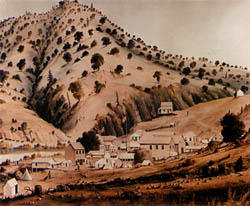Bidwell's Bar, California
39°33′24″N 121°26′29″W / 39.55667°N 121.44139°W

Bidwell's Bar (also known as Bidwell Bar) was a gold mining camp in Butte County, California, United States, which lay at the end of the California Trail. It lay at an elevation of 902 feet (275 m).
It was founded by John Bidwell, who discovered gold near the Middle Fork of the Feather River in 1848. By 1851, the camp had attracted enough miners to warrant a post office, and by 1853, the town's population swelled to 3,000, becoming prominent enough to become the county seat. A fire destroyed much of the town in 1854, but it was quickly rebuilt.
Ferrying people and supplies across the river proved to be difficult, especially during the winter months, and funds were raised to construct the Bidwell Bar Bridge, the first suspension bridge west of the Mississippi River. The bridge was completed in 1856.
As quickly as the town rose, it went into decline. By the end of 1856, the year the bridge was completed, the gold disappeared and the San Francisco Bulletin called it "Another Deserted Village." Miners were instead going to nearby Ophir (now Oroville). Within a year, the population was down to 200, and by 1882, only 30 people remained. The last remnants of the town were submerged with the creation of Lake Oroville in 1968, and only the original bridge and the clock tower (in Butte County Historical Museum) are left. Another survivor of the town is the Mother Orange Tree, the first orange tree in Northern California.
The site of the town has been declared a California Historical Landmark (#330).
References
- Kurutz, Gary F. "Bidwell's Bar". California Gold Rush Camps. Retrieved 2005-09-06.
- U.S. Geological Survey Geographic Names Information System: Bidwell's Bar, California

